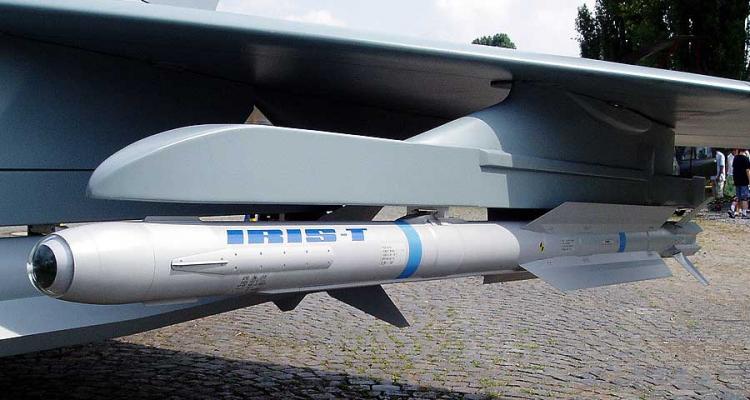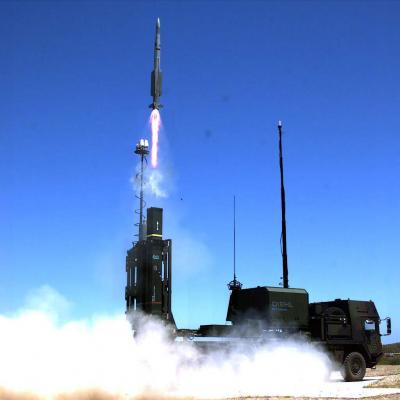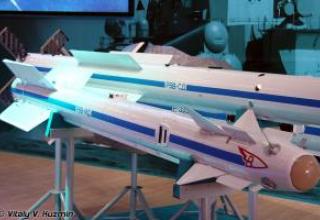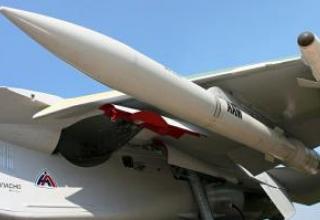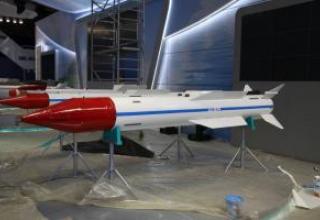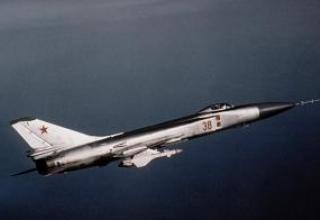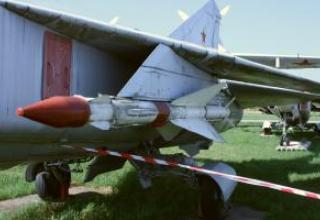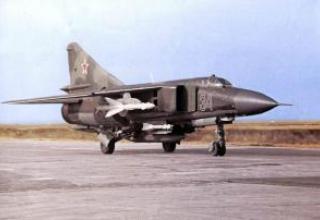Short range IRIS-T (Infra Red Imaging Seeker/system - Tail/thrust vector controlled) is an air-to-air guided missile designed to engage the entire range of air targets in close maneuverable air combat, day and night, in complex interference conditions.
The German company "Diehl BGT Defence" announced the beginning of the development of a new short-range missile to equip fighters EF-2000 and "Tornado" in July 1995. This missile was created as an alternative to the U.S. AIM-9X and the British ASRAAM, which, according to the command of the German Air Force did not meet modern requirements for close maneuverability and lost to the Soviet missiles R-73, already in service. In July 1996, the German government together with the governments of Canada, Greece, Italy, Norway and Sweden signed a "Memorandum of Understanding" covering the development and production of IRIS-T. The German government funded 47% of the programme cost, Italy 20%, Sweden 18%, Greece 8%, Canada 4% and Norway 3%. In 2001, the Canadian government decided to withdraw from the project.
The rocket is being developed by a European consortium that includes the following firms: "Saab Bofors Dynamics" (Sweden), NAMMO (Novogia), MBDA-IT (Italy), LITAL (Italy), "Magnaghi" (Italy), "Simmel" (Italy), SENER (Spain), ICSA (Spain), EXPAL (Spain), INTRACOM (Greece), HDS (Greece). The main contractor is "Diehl BGT Defence" (Germany).
Spain joined IRIS-T in October 2003 with an estimated purchase volume of 700 missiles to be used in the armament of Spanish F/A-18 and Typhoon fighters.
Flight tests of the rocket began in October 2000 with the F-4F "Phantom" and were successfully completed in November 2003. From 20 test launches in 7 launches were recorded direct hits to the maneuvering target (including at a range of about 10 km), in the rest of the missile was in the immediate vicinity of the target. The 1 billion euro contract between BWB (German Federal Office for Military Technology and Procurement) and Diehl BGT Defence for the supply of IRIS-T for the Air Forces of Germany, Greece, Italy, Norway, Spain and Sweden was signed on 20 December 2004. The total procurement volume under this contract is 4,000 for the period 2005-2011. The missile was officially put into service in December 2005. Currently, EF-2000 "Typhoon", F-16, F-18, "Gripen" and "Tornado" fighters are used as platforms for IRIS-T missiles. In 2002 the Norwegian government signed a contract with Lockheed Martin Aeronautics to study the integration of IRIS-T for the promising F-35 JSF.
The first export deliveries were made in December 2005 for the Austrian Air Force (25 units with the commissioning date of 2007). In 2008 it was announced about the conclusion of the contract on IRIS-T delivery for equipping "Gripen" fighters of the South African Air Force. IRIS-T was chosen as a temporary substitute for A-Darter missiles of its own production, which are under development. Denmark, the Netherlands, Portugal and Turkey are interested in IRIS-T.
On the basis of the IRIS-T aircraft control system, the IRIS-T SL short-range air defense system has been developed (see photo), as well as the IDAS anti-aircraft system designed for self-defense of submarines against anti-submarine helicopters and defeat of small surface targets. Serial production of IRIS-T SL began in 2014. This complex in a simplified version of SLS was ordered in small quantities by Sweden (delivery 2019) and Norway. The SLS complex in the Swedish version is located on the chassis of the dual-link armoured tracked transporter BAE Systems Hägglunds Bv 410. The German armed forces are planning to use the missiles of this system for integration into the promising MEADS air defense and missile defense system.
Composition:
The IRIS-T rocket (see the scheme) is designed according to the normal aerodynamic scheme and is equipped with a small elongation cross-shaped wide chord wing. Stabilizer planes with rectangular shapes are installed in the nose section of the hull. In the middle part of the rocket is a two-mode RDT by FiatAvio, equipped with a low smoky blend fuel charge. The RCTT provides a maximum flight speed of M=3. The tail section contains aerodynamic rudders and the engine thrust vector control system (TPV) unit (see photo). The RTDT is activated immediately after the missile departs from the launch guide and, together with the aerodynamic rudders, provides manoeuvring of the missile with its own overload up to 60g. According to the calculations of Western specialists, the IRIS-T missile can rotate through 180° in a horizontal plane with a bend radius half as small as that of the R-73.
The combat unit is a shrapnel-flagged one (weight 11.4 kg), driven by a non-contact radar or contact fuse. The combat unit is designed by the Greek company GPCC, while the non-contact fuse is by the Alenia-Marconi company.
The main elements of the IRIS-T missile guidance system are the TELL (developed by Diehl BGT Defence) and the inertial control system (developed by Litton, Italy). TGSN TELL (operating range 3-5mkm) is equipped with a fixed matrix of infrared detectors of indium antimonide 128h128 elements, located in the focal plane of the optical system. Movable element of the optical system TGSN is placed in a two-axis cardan suspension (see photo) and provides angles of pumping up to ± 90 ° at an angular velocity of the target line of sight up to 60 ° / sec. According to the developers, such a design of the homing head and the availability of digital data processing system provide high noise immunity and reliable target acquisition for auto tracking under conditions of intensive maneuvering. Maximum range of fighter type target capture in free space is estimated at 20 km. As the missile gets closer to the target, the data processing system builds its image (see photo) and compares it with images of typical targets (8 angles for each target) stored in the CPU memory. The TGS algorithm allows the missile to target the most vulnerable target areas.
The TGSN shroud is made of artificial sapphire (aluminum oxide). Cooling the matrix of infrared detectors to operating temperature is carried out using a source of refrigerant in the launcher aircraft carrier. The onboard power source is a thermopile.
For target designation the missile can use onboard and helmet sights, and the launch can be performed after the target is captured on the suspension or without it according to the primary target designation. High maneuverability of the IRIS-T missile ensures the launch at target viewing angles above 90° (over-the-shoulder firing) with TGSN target picking up on the trajectory at viewing angles beyond the view angles of the homing head, which gives a principal possibility to use IRIS-T as a means of self-defense of the carrier aircraft.
To launch the IRIS-T missile can be used all missile launchers "Sidewinder", including those with an analog interface. The missile is delivered to the troops in a special container (see photo) and does not require maintenance during its entire service life.
Ground-based air defense system SL/SLM uses a modified guided missile IRIS-T equipped with a more powerful engine as a means of destruction. The missile has a range of 40 km from the vertical launcher and an altitude of 20 km. The missile uses additional radio command guidance (combined with inertial-satellite correction) in the main trajectory section with infrared CNS type IIR target acquisition in the final section. The standard SLM version launcher is mounted on the chassis of the MAN SX 45 (8x8).
The SLM complex includes a multifunctional radar for target detection and tracking. The initial tests used Saab Giraffe radar (in particular, AMV), but in 2014, demonstration shooting was conducted with Australian multifunction radar CEA Technologies CEAFAR with AFAR (in the version for this radar was designated GBMMR). The BMD-Flex control and communication system by Danish company Terma A/S and the Oerlikon Skymaster combat control system by Rheinmetall Air Defence were used.
Characteristics:
| Maximum firing range, km | 25 (other data 12.5) |
| Maximum flight speed, M | 3 |
| Battle ceilings, m | 20000 |
| Dimensions, mm: - length - diameter - wingspan |
2936 127 447 |
| Starter weight, kg | 87.4 |
| Weight of combat unit, kg | 11.4 |
| Operating range of CNS wavelengths, µm | 3-5 |
Testing:
The combat operation of the complex and the functioning of its facilities in the process of firing are as follows.
Pulsed target designation radar AN/MPQ-50 and target designation station AN/MPQ-48, operating in continuous radiation mode, search and detect air targets. At the command post of the AN/TSW-8 battery during its operation together with the information processing station (and in the advanced firing platoon - at the control post AN / MSW-11) on the basis of the data received from these radars are solved problems of identification of targets, air situation assessment, identification of the most dangerous targets, issuing target designation of the firing section. After the target is captured by the illumination station AN/MPQ-46, it is accompanied in automatic or (as a rule, in a complex interference situation) manual mode. In the latter case, the operator of the battery command post uses the range information obtained from the radar rangefinder AN/MPQ-51. In the process of escorting the target, the backlighting station irradiates it. The launcher with the missile selected to fire the target is guided to a preemptive point. The homing head of the SSD captures the target.
After the command comes to the launch (from the battery control or from the control point of the forward firing platoon) the missile descends from the guide and, having reached a certain speed, starts to aim at the target. In doing so, its homing head uses signals reflected from the target and received from the illumination station (reference). The assessment of the firing results is made on the basis of the data obtained from the Doppler signal processing of the target illumination station at the information processing point.
Upgrade .
Improved Hawk" modernization program, which started in 1979, has now entered the third phase. At this stage, it is planned to carry out work in a number of areas, the main of which are:
- -Giving the complex the possibility of simultaneous hitting several targets by using an additional antenna with a wide beam in the radar. It is believed that when shooting at multiple targets, their range of engagement will be 50-70% of the range achieved when shooting at a single target.
- - Replacement of the battery control and information processing point by a control post, mainly similar to that of the forward firing platoon, but differing in the presence of a second control post and a digital computing device. Both control desks of the post are to be equipped with digital air-detection displays similar to those of the Patriot SAM system.
- - Increasing the mobility of the SAMs while reducing the number of transport units of the complex (from 14 to 7) by providing the possibility of transporting the SAMs to the PU and replacing the M-501E3 transport and charging machine with a machine equipped with a hydraulically driven hoist, which is based on a truck. On the new TZM and its trailer will be transported one rack with three ZUR on each. It is reported that the battery deployment and shutdown time will be halved.
- - Radar and PU equipment of the complex with navigation equipment and digital computing device to enable the complex to fire targets according to data from radar AN/MPQ-53 SAM "Patriot".
After the completion of the modernization program of "Improved Hawk" SAM systems in the U.S. and other NATO countries it is planned to create modifications of this complex that would better meet the requirements for combating modern means of air attack.
Thus, the American company "Reitheon" is developing ACWAR [Agile Continuous-Wave Acquisition Radar], which can be replaced by radars of both types. This three-axis station will have an antenna with electronic scanning of the beam on the angle of the place and mechanical - on azimuth. Mention is also made of the possibility (in case of creating a new modification of the missile) to use the radar ACWAR to point the SAM in the middle section of the flight path, excluding the target illumination station from the SAM.
The new modification of the Advanced Hawk designed for the Norwegian Armed Forces includes a three-axis LASR (Low Altitude Survellance Radar) radar developed by the American firm Hughes on the basis of the AN/TPQ-36 artillery position detection radar.
Sources:
- Системы управления вооружением истребителей: Основы интеллекта многофункционального самолета /РАРАН; Л.Е.Баханов и др.; под ред. Е.А.Федосова М.:Машиностроение, 2005.400с. (Справ.б-ка разработчика исследователя).
- IRIS-T
- BGT/SAAB/Alenia IRIS-T
